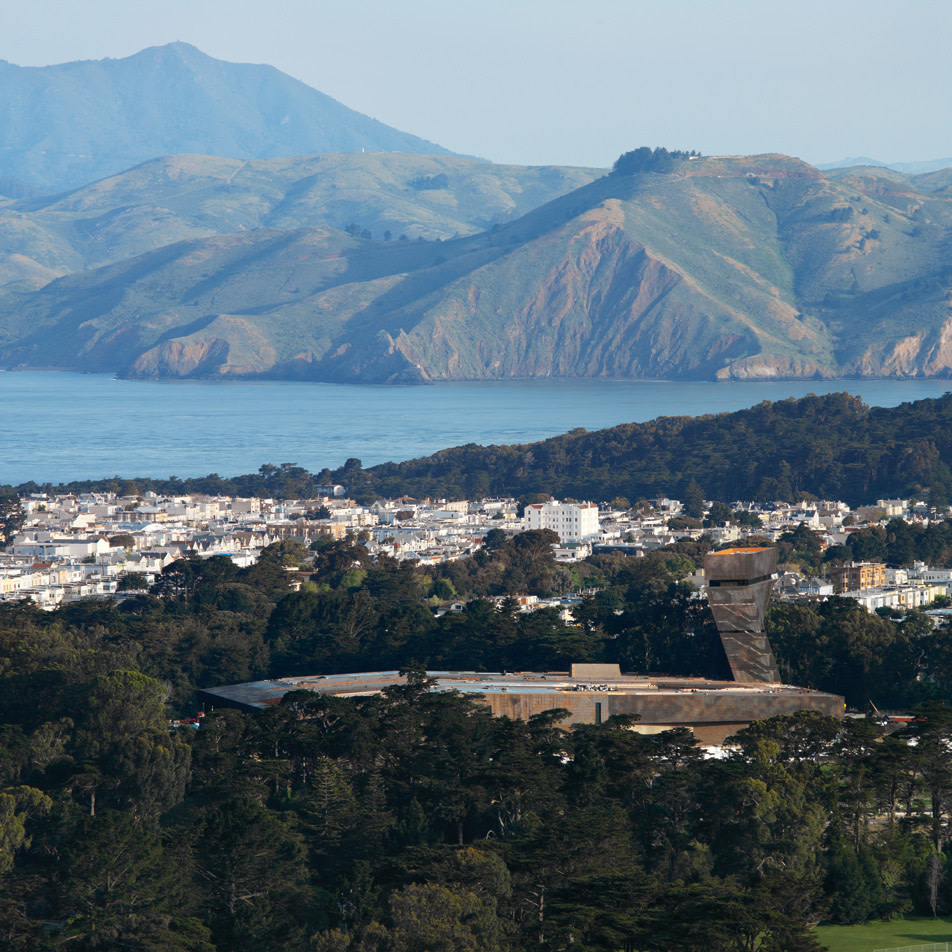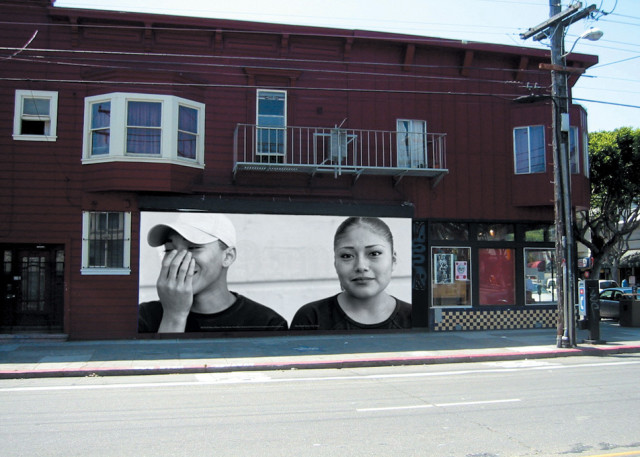Seize the Bay

The de Young Museum’s periscopic tower puts San Francisco and its famous bay in a new perspective.
Image: de Young Museum,de Young Museum
From the glass-walled observation gallery of the de Young Museum’s 144-foot tower, raised like a periscope nine stories above the lushly camouflaged sand dunes of Golden Gate Park, the view of San Francisco is panoramic and otherworldly. To the east, downtown skyscrapers peek out from the far edge of a rumpled quilt of neighborhoods with poetic names—Pacific Heights, Cow Hollow, the Tenderloin, Russian Hill, the Castro. To the north, the Golden Gate Bridge’s red suspension towers peer over the bluffs of the Presidio, and beyond, the gentle hills of the Marin headlands stretch westward to meet the hazy blue of the Pacific Ocean.
The de Young’s lofty platform serves as an appropriate launch pad for my three-day swing through San Francisco’s rollicking landscape of venerable art museums, high-gloss galleries and alternative art spaces. Less flashy than LA and more well-heeled than Seattle, San Francisco is the West Coast’s oldest art center, the birthplace of Isadora Duncan and Ansel Adams, of the Bay Area Figurative painters and photorealism, of revolutionary movements in ceramic art and robot performance art—a city of stubborn innovators that is continuously reinventing itself.
SoMa is a teeming agora of museums and cultural venues.
The de Young is the newest emblem of the city’s artistic regeneration. Back on the museum’s ground level, I watch kids scamper through the front courtyard, where a fissure zigzags through paving stones and cleaves several scattered hunks of rock. No, it’s not the remnant of an earthquake; it’s British artist Andy Goldsworthy’s Drawn Stone , a tongue-in-cheek nod to the 1989 Loma Prieta temblor that nearly toppled the museum’s previous home. San Francisco’s oldest major museum, founded in 1895, the de Young occupied a Spanish Plateresque-style building near the center of Golden Gate Park from 1919 until 2005, when museum leaders hired celebrity Swiss architecture firm Herzog & de Meuron to replace it with a copper-clad behemoth of sui generis modern design—a monumental sculpture (which will eventually turn verdigris) studded with gardens and site-commissioned artworks by international greats. Since its opening, the $200 million building has become a destination unto itself—and an apt symbol of a city that courts the future even as it preserves its past.
As for San Francisco’s artistic present, it seems immersed in a continuous state of exhilarating upheaval. Nowhere is that tumult more palpable than in the Mission District, a low-rise, culturally diverse stretch of neighborhoods occupying several square miles southwest of downtown. Walking west down 24th St from its intersection with Bryant Street, I go hunting for upstart storefront galleries, where tomorrow’s artistic legends will cut their teeth. This recently colonized node of the Mission is anchored by Galería de la Raza, which has shown work by contemporary Latino artists for 37 years. “You’ll see a lot of Latino-owned beauty shops, taquerías and hardware stores around here,” explains gallery manager Raquel de Anda, a young woman sporting thick-framed, nerdily hip glasses, “but the shop owners can’t afford to live here anymore.” True, the once primarily Hispanic area is booming and diversifying, for better or for worse. I pop my head into Sugarlump, a café outfitted with vintage midcentury furniture, but at de Anda’s recommendation I lunch at El Metate, a Zagat-rated burrito joint that serves deliciously flaky fish tacos and homemade tortilla chips. Business is so brisk that the owner is expanding into an adjacent space.
Sunset magazine is building one of its annual “idea” houses, a three-story luxury model home complete with lap pool, catty-corner from the newly opened Eleanor Harwood Gallery on 1295 Alabama St, a few long blocks from Galería de la Raza. On the gallery walls hang Spencer Mack’s digitally manipulated photos depicting cars and trains on the brink—and in the aftermath—of collisions. Harwood, the gallery’s owner, it turns out, used to curate shows at the Backroom Gallery in Adobe Books, a favorite hangout of artists in the Mission School, a Bay Area art movement that emerged only a few years ago. The Mission School’s lowbrow, bohemian aesthetic has found expression in graffiti murals, recycled-object sculptures, scrawled drawings and other works executed in a so-called urban rustic style. One of its best-known exemplars, Chris Johanson, relocated to Portland a few years ago, creating a stir. Evidently, Harwood is over it. “We’ve kind of gone through the Mission School thing,” she says. “There’s been a shift to a more intellectual, professional, written-about art scene.”
Or not. Adobe Books and its milieu near 16th St & Mission—including Johanson’s trendsetting gallery, Jack Hanley, and the Lab, a nonprofit art and performance space sited in an old labor hall—crouch among convenience stores, pawn shops, ritzy boutiques, expensive restaurants and bars where locals clamor until the wee hours. Today the Backroom Gallery is locked, but Johanson and his wife, Jo Jackson, also an artist, happen to be in the bookstore. “We got commissioned to do an installation at a hotel,” Jackson says. “It’s kind of like a library. I’m shopping for books. Chris is going to build a shelf.”
{page break}

The Mission’s Galería de la Raza.
Image: de Young Museum,de Young Museum
My friend Carol, a landscape architect and ceramist, joins me in trolling the busy neighborhood as the shops near closing time. She introduces me to the gruesome wonders of Paxton Gate, an eclectic boutique where exotic plants and preserved bits of flora and fauna—from decomposed leaf skeletons to a taxidermied giraffe—occupy gleaming vitrines and tabletops, where they are arranged in artful jumbles. I ponder a pair of handmade Indian scissors and a lush fox tail (as in, the tail of a fox, for $23), then settle on a tequila-flavored lollipop, complete with worm, as a gift for my boyfriend.
Carol and I grab a beer at a neighborhood dive, then return to the Tenderloin to dine with her husband, John, at Canteen. In 2005, chef Dennis Leary, formerly of Rubicon, transformed this erstwhile diner into an intimate, low-key purveyor of wholesome haute cuisine. From the brioche rolls and unexpectedly delicate fried smelt fish appetizer to the flaky apple tart, Leary’s fresh takes on familiar foods are, for the most part, exquisite and—fortunately—served just a few blocks from where I’m staying, at the recently opened Orchard Garden Hotel near Union Square.
In the morning I walk to the South of Market (SoMa) district, bypassing the shopper’s paradise of luxury chain boutiques and department stores that constitute the Union Square district. SoMa, which the city began redeveloping in the ’80s, is a teeming agora of museums and cultural venues. The central Yerba Buena Gardens, a tropically landscaped plaza, ensconces the Yerba Buena Center for the Arts, a voluminous exhibit space for contemporary art with an adjacent 700-seat proscenium theater. Nearby loom the new Museum of the African Diaspora, the Museum of Craft & Folk Art, the Cartoon Art Museum and SF Camerawork, a nonprofit photography gallery and education center. Soon San Francisco’s Mexican Museum will relocate here, as will the Contemporary Jewish Museum (as of spring 2008), to be housed in a retrofitted power substation designed by architect Daniel Libeskind, the master planner for the new World Trade Center in New York City.
The mother ship of this international flotilla is the San Francisco Museum of Modern Art, the third-oldest modern-art-collecting institution in the country, founded in 1935. The Mario Botta-designed building, where SFMOMA has resided since 1995, is easy to spot at Third & Mission, its cylindrical atrium of zebra-striped stone pushing up through the roof like a steamer’s funnel. Through an aggressive acquisition policy and curatorial push that began in the ’70s, SFMOMA has become a major international player, and the day I visit, two blockbuster shows—a retrospective of Brice Marden’s minimalist and abstract paintings and drawings, and a survey called Picasso and American Art —are being installed in its main galleries. Still, I spend a couple hours exploring the permanent collection—an impressive array of American and European works from Impressionism to the present.
49 Geary is a gallery hive of the city’s blue-chip art dealers.
A few blocks northwest of SoMa, in the Union Square district, a parade of orange banners projects from the historic façade of the gallery hive known as 49 Geary, heralding the names of numerous blue-chip dealers. Entering through a marble foyer, I take the elevator to the fifth floor and work my way down, pausing at one of the reception desks to pick up the San Francisco Bay Area Gallery Guide , a bimonthly pamphlet containing maps and information on dozens of current exhibitions throughout the Bay Area. At Fraenkel Gallery on the fourth floor, I drink in a deceptively simple show of large-scale prints by master Japanese photographer Hiroshi Sugimoto. Images of white walls, shot in color, they glow with an eerie, supernatural light. Fraenkel represents some of the world’s best photographers, including Oregon’s own Robert Adams, whose quietly searing images of landscapes in distress earned him a MacArthur “genius” fellowship and will be featured in a must-see show here April 5-May 26.
Tonight I’ll hit the ballet, and tomorrow the Asian Art Museum, with its stupendous collection spanning cultures from Persia to Korea over a period of 6,000 years, but I confess I’m reaching cultural overload. Before I leave 49 Geary, I step into Steven Wolf Fine Arts, where an artist named Mark Lee Morris has arranged a yoga mat, exercise gear and a video monitor. The tape features Morris, attired in headband and running shorts, playing a supine workout instructor. “Now extend your leg. And—inhale, inhale; exhale, exhale.” The gallery owner averts his gaze, leaving me to breathe in peace, art now acting as mindful yogic guide. It’s just the second wind I need.




